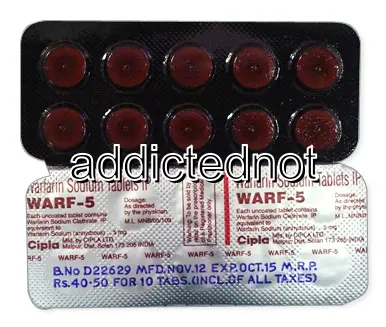| Package | Dosage | Price | Price per Dose | |
|---|---|---|---|---|
| Dosage: 1mg | ||||
| 360 pill | 1mg | $304.36 | $0.85 | |
| 180 pill | 1mg | $167.39 | $0.93 | |
| 120 pill | 1mg | $125.12 | $1.05 | |
| 90 pill | 1mg | $99.75 | $1.12 | |
| 60 pill | 1mg | $72.70 | $1.20 | |
| 30 pill | 1mg | $38.88 | $1.30 | |
| Dosage: 2mg | ||||
| 360 pill | 2mg | $365.24 | $1.01 | |
| 180 pill | 2mg | $197.83 | $1.10 | |
| 120 pill | 2mg | $142.03 | $1.18 | |
| 90 pill | 2mg | $114.97 | $1.29 | |
| 60 pill | 2mg | $86.22 | $1.44 | |
| 30 pill | 2mg | $49.02 | $1.66 | |
| Dosage: 5mg | ||||
| 360 pill | 5mg | $407.51 | $1.13 | |
| 240 pill | 5mg | $287.45 | $1.20 | |
| 180 pill | 5mg | $240.11 | $1.34 | |
| 120 pill | 5mg | $182.61 | $1.52 | |
| 90 pill | 5mg | $152.17 | $1.69 | |
| 60 pill | 5mg | $103.13 | $1.71 | |
| 30 pill | 5mg | $54.10 | $1.81 | |
| 20 pill | 5mg | $38.88 | $1.91 | |
| 10 pill | 5mg | $18.58 | $1.93 | |

Warfarin Description
Introduction to Warfarin
Warfarin is a widely used anticoagulant medication often prescribed to prevent and treat blood clots. It plays a crucial role in reducing the risk of stroke, deep vein thrombosis, pulmonary embolism, and other clot-related conditions. As a vitamin K antagonist, Warfarin works by inhibiting the synthesis of certain clotting factors in the liver, thereby decreasing blood's ability to form harmful clots. Its effectiveness makes it a vital component in managing various cardiovascular conditions. However, Warfarin also requires careful monitoring and dose adjustment to ensure safety and efficacy.
How Warfarin Works and Its Uses
Warfarin disrupts the formation of blood clots by blocking the activity of vitamin K, which is essential for producing clotting factors II, VII, IX, and X. Because of this mechanism, patients on Warfarin need regular blood tests, typically the INR (International Normalized Ratio), to measure how well their blood is clotting. Maintaining the INR within the target range is essential for preventing either clot formation or excessive bleeding. Warfarin is prescribed for patients with atrial fibrillation, prosthetic heart valves, or a history of thromboembolism. Its versatility makes it a cornerstone in anticoagulant therapy.
Benefits and Effectiveness
One of the main advantages of Warfarin is its long history of use, providing extensive clinical data supporting its safety and effectiveness when used properly. It is highly effective in preventing stroke in patients with atrial fibrillation and in avoiding recurrent blood clots. Warfarin is also beneficial for patients with mechanical heart valves, where other anticoagulants might not be suitable. When dosed correctly and monitored regularly, Warfarin can significantly reduce the risk of life-threatening thromboembolic events.
Potential Risks and Side Effects
Despite its benefits, Warfarin carries a risk of bleeding, which can be severe or even life-threatening. Common side effects include easy bruising, bleeding gums, or nosebleeds. Patients should be aware of the signs of bleeding and seek immediate medical attention if they occur. Other side effects are rare but can include skin necrosis and purple toe syndrome. Interactions with certain foods, medications, and supplements can affect Warfarin's effectiveness. Therefore, patients must maintain a consistent diet and inform their healthcare provider about all their medications.
Monitoring and Dosage Management
Proper management of Warfarin involves regular blood tests to monitor the INR. The target INR range varies depending on the indication but is usually between 2.0 and 3.0 for most conditions. Dose adjustments are made based on INR results, dietary intake, and concurrent medications. Patients are advised to avoid sudden changes in diet, especially foods rich in vitamin K, such as leafy greens. Consistent medication intake and routine monitoring are critical to balancing the benefits and risks of anticoagulation therapy with Warfarin.
Conclusion
Warfarin remains an essential medication for many patients at risk of blood clots. Its proven efficacy and long-standing clinical use make it a trusted option. However, its use requires diligent monitoring, a good understanding of potential interactions, and adherence to prescribed guidelines. Patients should communicate closely with their healthcare providers to ensure optimal therapy and minimize complications. When used correctly, Warfarin significantly improves outcomes for individuals with clotting disorders and related conditions.
